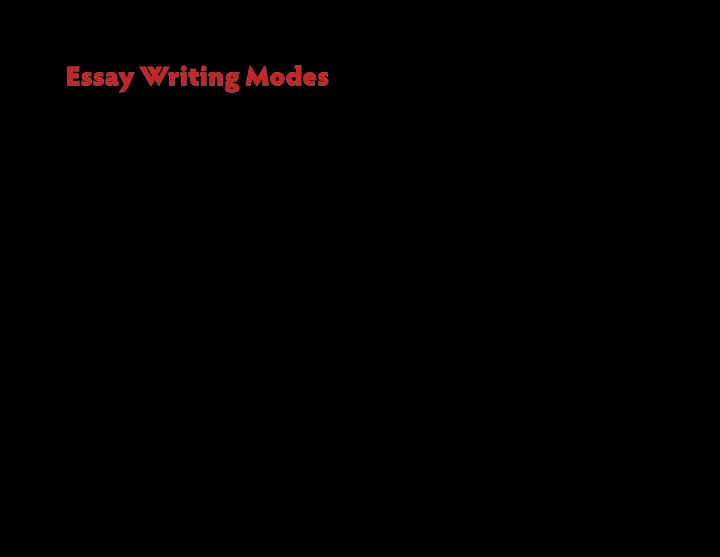

Essay Writing Modes revised 05.22.14 || English 1301: Composition I || D. Glen Smith, instructor
introduction Mode —a method or a process or act of doing; in a series modes direct to the same resolution. 2 revised 05.22.14 || English 1301: Composition I || D. Glen Smith, instructor
introduction There are seven modes we will examine through the course: ( These are sometimes referred to as Strategies ) Narration Description Comparison / Contrast Cause / Effect Defjnition Illustration • Argumentative 3 revised 05.22.14 || English 1301: Composition I || D. Glen Smith, instructor
Essay Writing Elements Confjrm the boundaries of the assignment: > date due > page restrictions or word count > prompt specifjcations Determine: } These four concepts are equally > purpose dependent on one another. > audience Any one of these categories can be > tone (formal or informal) a starting point for developing an essay for class > narrative voice to break down these four concepts further > 4 revised 05.22.14 || English 1301: Composition I || D. Glen Smith, instructor
Purpose • Although there exist numerous reasons for writing essays, the primary purpose of the assignments for this class serve to either: inform, persuade, or speculate. 5 revised 05.22.14 || English 1301: Composition I || D. Glen Smith, instructor
Audience • The general notion of a writer’s audience takes on many different forms. Even when writing a casual letter, it is best to keep in mind the intended recipient to aid in formulating your observations and defense strategies. • Visualizing a member of your reading audience can aid building a strong paper. • Likewise, it is important to consider: What information does your audience already know on the topic? What new information is necessary to provide? What is your audience’s attitude on the subject? Are they sympathetic, neutral, or against your opinion? What is your audience’s background? These questions help build defense strategies for Argument papers. 6 revised 05.22.14 || English 1301: Composition I || D. Glen Smith, instructor
Tone The answers to the above questions will also determine what tone or level of formality you should use in your essay. • In addition, consider: Do you want to cite anger in your audience? Do you want to motivate action as a community? – or – Would a formal or informal tone work best in these situations? 7 revised 05.22.14 || English 1301: Composition I || D. Glen Smith, instructor
Tone / Audience 1 2 3 4 5 6 7 8 9 10 academic, formal colloquial, informal research paper personal essay speech chatty/ bar scene 8 revised 05.22.14 || English 1301: Composition I || D. Glen Smith, instructor
Tone All writing naviagates around an author’s tone of voice. Emotional expressions help connect a writer to his/her audience. • Some obvious, random, emotional states that can be expressed in writing: anger resentment melancholy sarcasm hatred sorrow fear humor 9 revised 05.22.14 || English 1301: Composition I || D. Glen Smith, instructor
Narrative Voice Most importantly, different situations call for different types of narration . • Narrative voice (also known as points of view) is controlled by an author’s pronouns selections: fjrst person: me, myself, I, we, our, ourselves, us used in mostly informal (personal) situations such as Narration and Description modes < in fjction, Edgar Allan Poe utilized this form frequently second person : you, yours, your, yourself used in both informal and formal situations; exclusively in Process modes < in poetry, Susan Mitchell utilized this form in her work “Wave” third person: he, she, it, they, them used mostly in formal (academic research) situations < commonly used in research; strengthens the voice of authority 10 revised 05.22.14 || English 1301: Composition I || D. Glen Smith, instructor
Stream of Consciousness Another unique type of Narration is termed stream of consciousness. In itself, this narrative form is rather experimental, serving an eccentric approach to writing. • It defjnitely does not suit an academic research paper. • Utilized heavily in the Modernist movement which began in the early stages of the Twentieth Century • It operates similarly to a free-write session. The author composes his/her material as a chain of thoughts; the reader is dropped into a prose-recording of a character’s thought process as an event unfolds to the perspective of the main character. • Strong examples of this style can be found within the works of William Faulkner, James Joyce, and Virginia Woolf. 11 revised 05.22.14 || English 1301: Composition I || D. Glen Smith, instructor
Recommend
More recommend